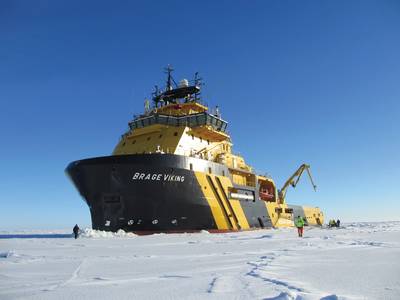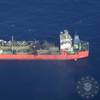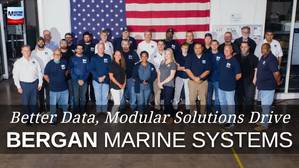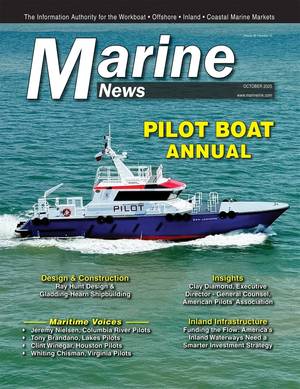AHTS Proves Strength on (in & through) Ice
While the large oceangoing variety of ships garners the lion’s share of attention in regards to Arctic operations, modern offshore vessels that will be required to support potential oil and gas business in the region are equally vital. Viking Supply Ships recently carried out full scale ice trials in the Gulf of Bothnia on the Brage Viking, an 85m long anchor handling tug supply (AHTS) type offshore support vessel delivered from Zamakona shipyard in Spain two years ago.
The AHTS was built to Finnish-Swedish ice class 1A standards and is powered by a pair of MaK 8M32C 4,000kW and a pair of MaK 6M32C 3,000kW main engines, with a combined power output of 19,050 hp. The engines drive two nozzled CPP propellers supplied by Caterpillar Propulsion.
The Spanish-built vessel was put to the test in three areas with ice thickness ranging from 8 to 20 inches, and it showed that while it was not specifically designed for ice breaking duties, Brage Viking’s performance in light to moderate ice conditions was at the same level as that of purpose-built Arctic supply icebreakers.
“We saw an opportunity to test Brage Viking to evaluate its performance in ice conditions and to demonstrate to customers, classification societies and flag state authorities its ability to operate safely in various types of ice,” said Andreas Kjol, Viking’s project director. “These tests were unique, and of special importance, because opportunities like this are quite limited. Generally it can be said the vessel’s performance in the ice conditions encountered was somewhat better than predicted.”
The tests included going ahead and astern in level ice and channels, turning circle tests and ice ridge penetration.
During the test the Brage Viking achieved a maximum speed ahead in level ice, with a 12-20-in. thickness, of 13.5 knots. Astern icebreaking also tested with good results.
The vessel has an open water bulbous bow which can break ice by bending ice upwards when a suitable bow draft is selected, and the tests showed that the vessel could penetrate typical ridges easily, while the bulbous bow could break ice running at operational speeds when the draft was correct.
“One of the things we learned from these tests was the correct operational drafts to optimize ice-breaking,” said Kjol. “We also learned that if required, small modifications to the upper part of the bulbous bow would increase the draft range and the performance of the bulbous bow, especially in heavier ice conditions, without sacrificing performance in open water.”
The bow of sister ship Loke Viking was modified after these tests.
Power for Ice Ops
The vessel’s four main engines are connected via reduction gears to twin shaft CP-propellers. The twin rudders have a maximum turning angle of 70 degrees and can be operated separately. The lower side of the propeller nozzle and the rudders are installed about 35 in. below the hull bottom line and are attached to the hull by a fin support, reducing ice loads and propeller/nozzle ice interaction.
The tests showed that the vessel could make a clean channel and that, by turning the rudders in the opposite direction, the channel could be widened further. At a maximum speed of 13-14 knots the ship broke the ice field to a width of five to six times that of the vessel through its own wave pattern.
Maneuvering performance was rated as ‘good,’ and the vessel was able to also break out of its own channel backwards with rudders centered, just by changing the pitch of the inner curve propeller in an opposition direction.
As the nozzled propellers were located relatively deep down, with a good hull clearance, almost no propeller-ice interaction was noted.
“We needed to have more information about how the Brage Viking performed in ice, and to show to customers what she is capable of doing safely,” said Kjol. “So this was a valuable exercise as we learned more about the scope for using this vessel for ice breaking duties; while the crew also learned a lot of about its behavior in ice.”
Viking Ship Supply provides offshore support services in harsh environments, especially in Arctic regions, and the company is experienced operating in the Baltic, where for 14 years it has performed ice-breaking services for the Swedish government.
“Brage Viking handled the conditions found in the northern Baltic in February very well,” said Kjol. “Operating as we do in remote regions, where a vessel can be three days from the nearest harbor, we need to have reliable equipment on board. The propulsion system in particular has to be extremely reliable as downtime in these circumstances is not an option.” Viking Ship Supply now has two years of experience operating the Brage Viking, and in that time the MaK engines and Caterpillar Propulsion propellers have performed very well, with a high degree of reliability.
(As published in the November 2014 edition of Maritime Reporter & Engineering News - http://magazines.marinelink.com/Magazines/MaritimeReporter)














